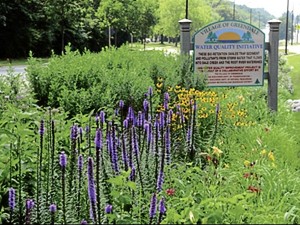
STORMWATER from city streets is directed into and then naturally filtered through “bio-swales” in the Milwaukee Metropolitan Sewerage District. Photo by Robert Kuehn
Scarcity of water in the time of King Herod nearly a hundred years BC dictated the whole vocabulary of the built form in that area. Rainfall was collected in cisterns on mountain slopes and exploited to supply water by force of gravity to three levels of his masterpiece of planning, the Masada on a mountaintop.
Rainfall of less than 50 mm per year in many places there called for run-off water from rain and winter snow to be collected with great sophistication. Dry riverbeds were terraced and stones gathered from slopes were used to cap the ground and direct run-off water to the terraces, so that the amount of water that reached the dry riverbeds or wadis was 30 times more. This way the vast arid zone maintained orchards and plantations to supply food for the whole population.
Scarcity of water continues to our time in that part of the world. While the south of the globe struggles now for climate change adaptation, the wealthier north is busy with climate change mitigation.
Legal policy
Fortunately for us, our rich human capital, which we will just have to develop much more effectively, is slowly but surely turning the tables around. Unless of course some truly unenlightened legal policy breaks the trend of our fortune, we have reason to be optimistic.
With an average number of 20 typhoons visiting our country every year, we have to look at storm water as a resource to be collected and used, where needed.
Many people in the world will not believe that we use potable water to water the garden, clean the car, flush the toilet. We have to popularly develop rainwater harvesting and gray water use.
Erratic weather patterns call for us to operate efficient drainage and run-off systems. Neglect of land-use planning worsens the situation because of the building of new developments. This covers large areas of water-absorbing ground with solid concrete surfaces. Consequently, the natural flow of water is altered to such an extent that we have more flooding.
Added to this, sea water defenses cannot anymore cope with the rise in the tide and we begin to experience storm surge risks.
As the city grows more and more in its magnetism as the place for the creation of wealth, consumerism and entertainment, we need sharp criteria for truly enlightened city officials. We have to choose those with longer-term goals for us than the next election for them.
Allowable mix
Urban developments must have an allowable mix of permeable and nonpermeable surfaces for replenishment of groundwater.
Reed beds and other wastewater treatment systems should be given incentives.
Swales, basins, filter drains that reduce flooding give high points in green building assessment standards.
The use of ponds and other water features to control storm water flows can be studied to include social and cultural amenities.
Roof gardens reduce rainwater run-off. City farming is an attractive goal for many cities now. In some places they are calling for policies to require vacant lot owners to do or allow edible farming on their properties.
For comments or inquiries, e-mail amadodejesus@gmail. com